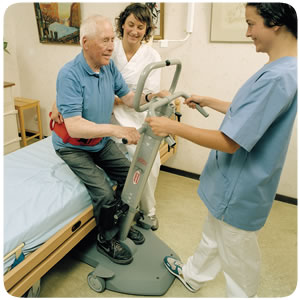
Photo is provided with permission from Nottingham rehab
This can be graded so that gradually the person starts to take control of more of their body weight.
In the early stages a hoist may be the only safe option for getting the person from bed to chair or commode. As they improve partial weight bearing is possible using different types of standing aid such as the one in the picture.
Once the person can stand while holding on to a rail with assistance, they can then use this method as part of therapy, when dressing to have lower clothes pulled up for example.
Usually once a person can sit unsupported without falling over then the therapist will begin working on their standing balance. The therapist will do specific exercises for the leg and back muscles and assist the person to stand up. In the early days this may require a lot of support from staff and/or the assistance of a standing hoist. If they continue to improve then the support will be reduced and the person will be encouraged to take more control. Once the person is able to stand in a safe manner they may then be encouraged to practice this in the ward during functional tasks (e.g. using the toilet, moving from bed to chair, washing and dressing) with support from staff as required.
Movement (motor control) of the arm and leg
The therapist will work to try and improve the control and movement of the arm and leg. Therapy for this may include stretches, doing movements with the help of the therapist, independent movement, weight bearing tasks and strengthening exercises.
Functional ability
The therapist will work to try and make the person as independent as possible. They will work on functional tasks for example getting from a bed to chair; walking; wheelchair mobility; stairs and on/off the floor.